Enhancing the Punching Load Capacity of Reinforced Concrete Slabs Using an External Epoxy-Steel Wire Mesh Composite
Abstract
1. Introduction
2. Experimental Investigation
2.1. Concrete
2.2. Steel Reinforcement
2.3. Steel Wire Mesh
2.4. Epoxy Adhesive
2.5. Strengthening Application
3. Testing Procedure
4. Results and Discussions
4.1. Load-Deflection Response
4.2. Modes of Failure
4.3. Critical Section Perimeters
4.4. Ductility Index and Ultimate Reserve Shear
5. Conclusions
- This new technique of using a composite of steel wire mesh fully coated with epoxy and externally attaching it to the slab surface was found as an effective, easy, and practical way of strengthening reinforced concrete flat plates and enhancing their capacity against punching shear failure.
- The strengthening composite did not alter the mode of failure, which indicates that the same principles, assumptions, and failure criteria can be extended to formalize the enhancing achievement. No debonding occurred between the strengthened materials and slabs.
- All types of strengthening composite configurations achieved an incremental increase in the ultimate punching shear load capacity and a decrease in the corresponding failure deflection.
- The maximum increase in the punching shear load capacity was 28%. Further, a minimum load deflection was achieved by the skewed strengthening configuration; it was 7% for the parallel at 1.5 d slab.
- Although the ultimate shear stress at the critical sections of the strengthened slabs increaesed to a maximum value of 2.95 MPa, it is well below the limits of BS 8110.
- The maximum drop in ductility was experienced by the high strength concrete slab (13%). Further, the minimum (1.7%) was experienced by the skewed strengthened normal concrete slab.
- The 45° skewed configuration strengthening composite was the most efficient among the strengthened slabs investigated in this study. The maximum percentage of reserve shear attained by this configuration increased to 44% compared with the reference slab.
Author Contributions
Funding
Acknowledgments
Conflicts of Interest
References
- Youm, K.S.; Kim, J.J.; Moon, J. Punching shear failure of slab with lightweight aggregate concrete (LWAC) and low reinforcement ratio. Constr. Build. Mater. 2014, 65, 92–102. [Google Scholar] [CrossRef]
- Elsanadedy, H.M.; Al-Salloum, Y.A.; Alsayed, S.H. Prediction of punching shear strength of HSC interior slab-column connections. KSCE J. Civ. Eng. 2013, 17, 473–485. [Google Scholar] [CrossRef]
- Osman, M.; Marzouk, H.; Helmy, S. Behavior of high-strength lightweight concrete slabs under punching loads. ACI Struct. J. 2000, 97, 492–498. [Google Scholar]
- Macdonald, M.; Calder, A. Bonded steel plating for strengthening concrete structures. Int. J. Adhes. Adhes. 1982, 2, 119–127. [Google Scholar] [CrossRef]
- Meisami, M.H.; Mostofinejad, D.; Nakamura, H. Punching shear strengthening of two-way flat slabs using CFRP rods. Compos. Struct. 2013, 99, 112–122. [Google Scholar] [CrossRef]
- Thanoon, W.A.; Jaafar, M.; Kadir, M.R.A.; Noorzaei, J. Repair and structural performance of initially cracked reinforced concrete slabs. Constr. Build. Mater. 2005, 19, 595–603. [Google Scholar] [CrossRef]
- Martinez-Cruzado, J.; Qaisrani, A.; Moehle, J. Post-tensioned flat plate slab-column connections subjected to earthquake loading. In Proceedings of the 5th US National Conference on Earthquake Engineering, Chicago, IL, USA, 10–14 July 1994; pp. 139–148. [Google Scholar]
- Hassanzadeh, G.; Sundquist, H. Strengthening of bridge slabs on columns. Nord. Concr. Res. Publ. 1998, 21, 23–34. [Google Scholar]
- Polak, M.A. Ductility of Reinforced Concrete Flat Slab-Column Connections. Comput. Aided Civ. Infrastruct. Eng. 2005, 20, 184–193. [Google Scholar] [CrossRef]
- Ruiz, M.F.; Muttoni, A.; Kunz, J. Strengthening of Flat Slabs against Punching Shear Using Post-Installed Shear Reinforcement. ACI Struct. J. 2010, 107, 434–442. [Google Scholar]
- Farhey, D.N.; Adin, M.A.; Yankelevsky, D.Z. Repaired RC Flat-Slab-Column Subassemblages under Lateral Loading. J. Struct. Eng. 1995, 121, 1710–1720. [Google Scholar] [CrossRef]
- Raithby, K.D. Strengthening of concrete bridge decks with epoxy-bonded steel plates. Int. J. Adhes. Adhes. 1982, 2, 115–118. [Google Scholar] [CrossRef]
- Meier, U. Strengthening of structures using carbon fibre/epoxy composites. Constr. Build. Mater. 1995, 9, 341–351. [Google Scholar] [CrossRef]
- Bakis, C.; Davalos, J.F.; Lesko, J.J.; Machida, A.; Rizkalla, S.H.; Triantafillou, T.; Bank, L.C.; Brown, V.L.; Cosenza, E. Fiber-Reinforced Polymer Composites for Construction—State-of-the-Art Review. J. Compos. Constr. 2002, 6, 73–87. [Google Scholar] [CrossRef]
- Li, H.; Wang, W.; Zhou, W. Fatigue damage monitoring and evolution for basalt fiber reinforced polymer materials. Smart Struct. Syst. 2014, 14, 307–325. [Google Scholar] [CrossRef]
- Ju, M.; Park, K.; Park, C. Punching Shear Behavior of Two-Way Concrete Slabs Reinforced with Glass-Fiber-Reinforced Polymer (GFRP) Bars. Polymer 2018, 10, 893. [Google Scholar] [CrossRef] [PubMed]
- Smith, S.T.; Hu, S.; Kim, S.J.; Seracino, R. FRP-strengthened RC slabs anchored with FRP anchors. Eng. Struct. 2011, 33, 1075–1087. [Google Scholar] [CrossRef]
- Sundarraja, M.; Rajamohan, S.; Bhaskar, D. Shear Strengthening of RC Beams Using GFRP Vertical Strips —An Experimental Study. J. Reinf. Plast. Compos. 2008, 27, 1477–1495. [Google Scholar] [CrossRef]
- Erki, M.; Heffernan, P. Reinforced concrete slabs externally strengthened with fibre-reinforced plastic materials. In Proceedings of the second international RILEM symposium FRPRCS-2, Belgium, Ghent, 23–25 August 1995; pp. 209–516. [Google Scholar]
- Kheyroddin, A.; Vaez, S.R.H.; Naderpour, H. Numerical Analysis of Slab-Column Connections Strengthened with Carbon Fiber Reinforced Polymers. J. Appl. Sci. 2008, 8, 420–431. [Google Scholar]
- Harajli, M.H.; Soudki, K.A. Shear Strengthening of Interior Slab–Column Connections Using Carbon Fiber-Reinforced Polymer Sheets. J. Compos. Constr. 2003, 7, 145–153. [Google Scholar] [CrossRef]
- El-Salakawy, E.; Soudki, K.A.; Polak, M.A. Punching Shear Behavior of Flat Slabs Strengthened with Fiber Reinforced Polymer Laminates. J. Compos. Constr. 2004, 8, 384–392. [Google Scholar] [CrossRef]
- Harajli, M.H.; Soudki, K.A.; Kudsi, T. Strengthening of Interior Slab–Column Connections Using a Combination of FRP Sheets and Steel Bolts. J. Compos. Constr. 2006, 10, 399–409. [Google Scholar] [CrossRef]
- Wang, J. Punching Shear Behaviour of RC Flat Plates Externally Strengthened with FRP Systems; National University of Singapore: Singapore, 2002. [Google Scholar]
- Sharaf, M.H.; Soudki, K.A.; Van Dusen, M. CFRP Strengthening for Punching Shear of Interior Slab-Column Connections. J. Compos. Constr. 2006, 10, 410–418. [Google Scholar] [CrossRef]
- Soudki, K.A.; El-Sayed, A.K.; Vanzwol, T. Strengthening of concrete slab-column connections using CFRP strips. J. King Saud Univ. Eng. Sci. 2012, 24, 25–33. [Google Scholar] [CrossRef]
- Chiew, S.P.; Sun, Q.; Yu, Y. Flexural Strength of RC Beams with GFRP Laminates. J. Compos. Constr. 2007, 11, 497–506. [Google Scholar] [CrossRef]
- Grace, N.F.; Sayed, G.A.; Soliman, A.K.; Saleh, K.R. Strengthening reinforced concrete beams using fiber reinforced polymer (FRP) laminates. ACI Struct. J. Am. Concr. Inst. 1999, 96, 865–874. [Google Scholar]
- Ritchie, P.A.; Thomas, D.A.; Lu, L.W.; Connely, G.M. External Reinforcement of Concrete Beams Using Fiber Reinforced Plastic. ACI Struct. J. 1991, 88, 490–500. [Google Scholar]
- Toutanji, H.; Zhao, L.; Zhang, Y. Flexural behavior of reinforced concrete beams externally strengthened with CFRP sheets bonded with an inorganic matrix. Eng. Struct. 2006, 28, 557–566. [Google Scholar] [CrossRef]
- Triantafillou, T.C.; Plevris, N.; Triantafillou, T. Strengthening of RC beams with epoxy-bonded fibre-composite materials. Mater. Struct. 1992, 25, 201–211. [Google Scholar] [CrossRef]
- Sharif, A.; Al-Sulaimani, G.J.; Basunbul, I.A.; Baluch, M.H.; Ghaleb, B.N. Strengthening of Initially Loaded Reinforced Concrete Beams Using FRP Plates. ACI Struct. J. 1994, 91, 160–168. [Google Scholar]
- Gose, S.; Nanni, A.J.R. Anchorage System for Externally Bonded FRP Laminates Using Near Surface Mounted Rods; Centre for Infrastructure Engineering Studies, University of Missouri-Rolla: Rolla, MI, USA, 2000. [Google Scholar]
- Smith, S.T.; Teng, J.-G. Shear-Bending Interaction in Debonding Failures of FRP-Plated RC Beams. Adv. Struct. Eng. 2003, 6, 183–199. [Google Scholar] [CrossRef]
- Wu, Y.-F.; Huang, Y. Hybrid Bonding of FRP to Reinforced Concrete Structures. J. Compos. Constr. 2008, 12, 266–273. [Google Scholar] [CrossRef]
- Al-Mahaidi, R.; Kalfat, R. Investigation into CFRP laminate anchorage systems utilising bi-directional fabric wrap. Compos. Struct. 2011, 93, 1265–1274. [Google Scholar] [CrossRef]
- Koutas, L.N.; Bournas, D.A. Flexural strengthening of two-way RC slabs with textile-reinforced mortar: Experimental investigation and design equations. J. Compos. Constr. 2016, 21, 04016065. [Google Scholar] [CrossRef]
- Abbaszadeh, M.A.; Sharbatdar, M.K.; Kheyroddin, A. Performance of Two-way RC Slabs Retrofitted by Different Configurations of High Performance Fibre Reinforced Cementitous Composite Strips. Open Civ. Eng. J. 2017, 11, 650–663. [Google Scholar] [CrossRef]
- ACI Committee 549. Guide for the design, construction, and repair of ferrocement. ACI Struct. J. 1988, 85, 325–351. [Google Scholar]
- Kondraivendhan, B.; Pradhan, B. Effect of ferrocement confinement on behavior of concrete. Constr. Build. Mater. 2009, 23, 1218–1222. [Google Scholar] [CrossRef]
- Fahmy, E.; Shaheen, Y. Laminated ferrocement for strengthening and repairing of reinforced concrete beams. In Proceedings of the Annual Conference of the Canadian Society for Civil Engineering, Winnipeg, MB, Canada, 1–4 June 1994; pp. 475–483. [Google Scholar]
- Fahmy, E.; Shaheen, Y.; Korany, Y.S. Repairing reinforced concrete columns using ferrocement laminates. J. Ferrocem. 1999, 29, 115–124. [Google Scholar]
- Shannag, M.J. High strength ferrocement laminates for structural repair. In Concrete Solutions; CRC Press: Boca Raton, FL, USA, 2009; pp. 385–388. [Google Scholar]
- Jeyasehar, C.; Vidivelli, B. Behaviour of RC beams rehabilitated with ferrocement laminate. In Proceedings of the Eight International Symposium and Workshop on Ferrocement and Thin Reinforced Cement Composites, Bangkok, Thailand, 6–8 February 2006; pp. 485–500. [Google Scholar]
- Lub, K.; Van Wanroij, M.J.J.o.f. Strengthening of reinforced concrete beams with shotcrete-ferrocement. J. Ferrocem. 1989, 19, 363–371. [Google Scholar]
- Paramasivam, P.; Lim, C.; Ong, K. Strengthening of RC beams with ferrocement laminates. Cem. Concr. Compos. 1998, 20, 53–65. [Google Scholar] [CrossRef]
- Dongyen, A.; Sayanamipuk, S.; Piyarakshul, S.; Nimityongskul, P. Strengtheing of reinforced concrete beam and slab system using ferrocement jacketing. In Proceedings of the Eight International Symposium and Workshop on Ferro Cement and Thin Reinforced Cement Composites, Bangkok, Thailand, 6–8 February 2006; pp. 461–472. [Google Scholar]
- Naaman, A.E. Ferrocement and Laminated Cementitious Composites; Techno Press: Ann Arbor, MI, USA, 2000; Volume 3000. [Google Scholar]
- El Debs, M.; Naaman, A. Bending behavior of mortar reinforced with steel meshes and polymeric fibers. Cem. Concr. Compos. 1995, 17, 327–338. [Google Scholar] [CrossRef]
- Shannag, M.J.; Bin Ziyyad, T. Flexural response of ferrocement with fibrous cementitious matrices. Constr. Build. Mater. 2007, 21, 1198–1205. [Google Scholar] [CrossRef]
- Ibrahim, H.M.J.C.; Materials, B. Experimental investigation of ultimate capacity of wired mesh-reinforced cementitious slabs. Constr. Build. Mater. 2011, 25, 251–259. [Google Scholar] [CrossRef]
- Kaish, A.; Jamil, M.; Raman, S.; Zain, M.; Nahar, L. Ferrocement composites for strengthening of concrete columns: A review. Constr. Build. Mater. 2018, 160, 326–340. [Google Scholar] [CrossRef]
- Li, X.; Xie, H.; Yan, M.; Gou, H.; Zhao, G.; Bao, Y. Eccentric Compressive Behavior of Reinforced Concrete Columns Strengthened Using Steel Mesh Reinforced Resin Concrete. Appl. Sci. 2018, 8, 1827. [Google Scholar] [CrossRef]
- Qeshta, I.M.; Shafigh, P.; Jumaat, M.Z.; Abdulla, A.I.; Ibrahim, Z.; Alengaram, U.J. The use of wire mesh–epoxy composite for enhancing the flexural performance of concrete beams. Mater. Des. 2014, 60, 250–259. [Google Scholar] [CrossRef]
- Qeshta, I.M.; Shafigh, P.; Jumaat, M.Z.; Abdulla, A.I.; Alengaram, U.J.; Ibrahim, Z. Flexural behaviour of concrete beams bonded with wire mesh-epoxy composite. In Applied Mechanics and Materials; Trans Tech Publications: Zurich, Switzerland, 2014; pp. 411–416. [Google Scholar]
- Qeshta, I.M.; Shafigh, P.; Jumaat, M.Z. Flexural behaviour of RC beams strengthened with wire mesh-epoxy composite. Constr. Build. Mater. 2015, 79, 104–114. [Google Scholar] [CrossRef]
- Iraqi Specification No.5/1984, “Portland Cement”; Central Organization for Standardization and Quality Control: Baghdad, Iran, 2001.
- ACI 211.1-91 Cmmittee. Standard Practice for Selecting Proportions for Normal, Heavyweight, and Mass Concrete; ACI Manual of Concrete Practice, Part 1; American Concrete Institute: Detroit, MI, USA, 1991; pp. 211.1-1–211.1-38. [Google Scholar]
- ACI 211.4R-93 Cmmittee. Guide for selecting proportions for high-strength concrete with Portland cement and fly Ash. ACI Mater. J. 1993, 90, 272–283. [Google Scholar]
- ASTM, S.J.A.A.A.M.-b. Standard Specification for Deformed and Plain Carbon-Steel Bars for Concrete Reinforcement; A615/A615M-09; ASTM International: West Conshohocken, PA, USA, 2009. [Google Scholar]
- Sika Product Data Sheet, Sikadur®-31 CF Normal, Product Data Sheet, 2-Components Thixotropic Epoxy Adhesive; Sika Product Data Sheet. Sika Group: Watchmead, Welwyn Garden City, UK, 2013; Volume 2031. Available online: https://gbr.sika.com/en/solutions_products/sika-markets/structural-strengthening/products-andsystems/02a013sa04.html (accessed on 21 July 2019).
- CEB-FIP MC-1990; Final draft, Model Code, Bulletin d’information; Comité Euro-International Du Béton-Fédération de laPrécontrainte: Lausanne, Switzerland, No. 203; 1991; p. 462.
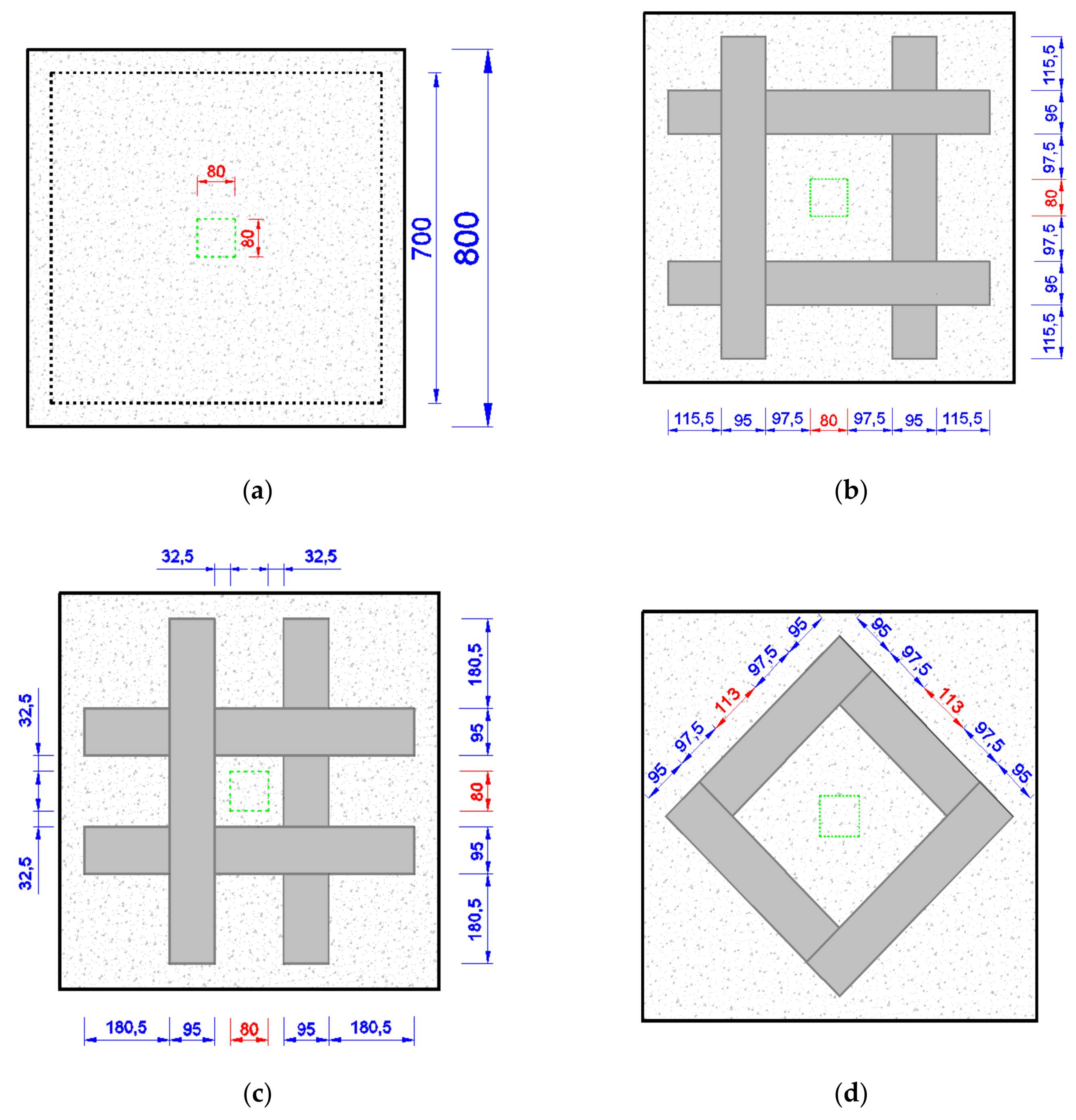
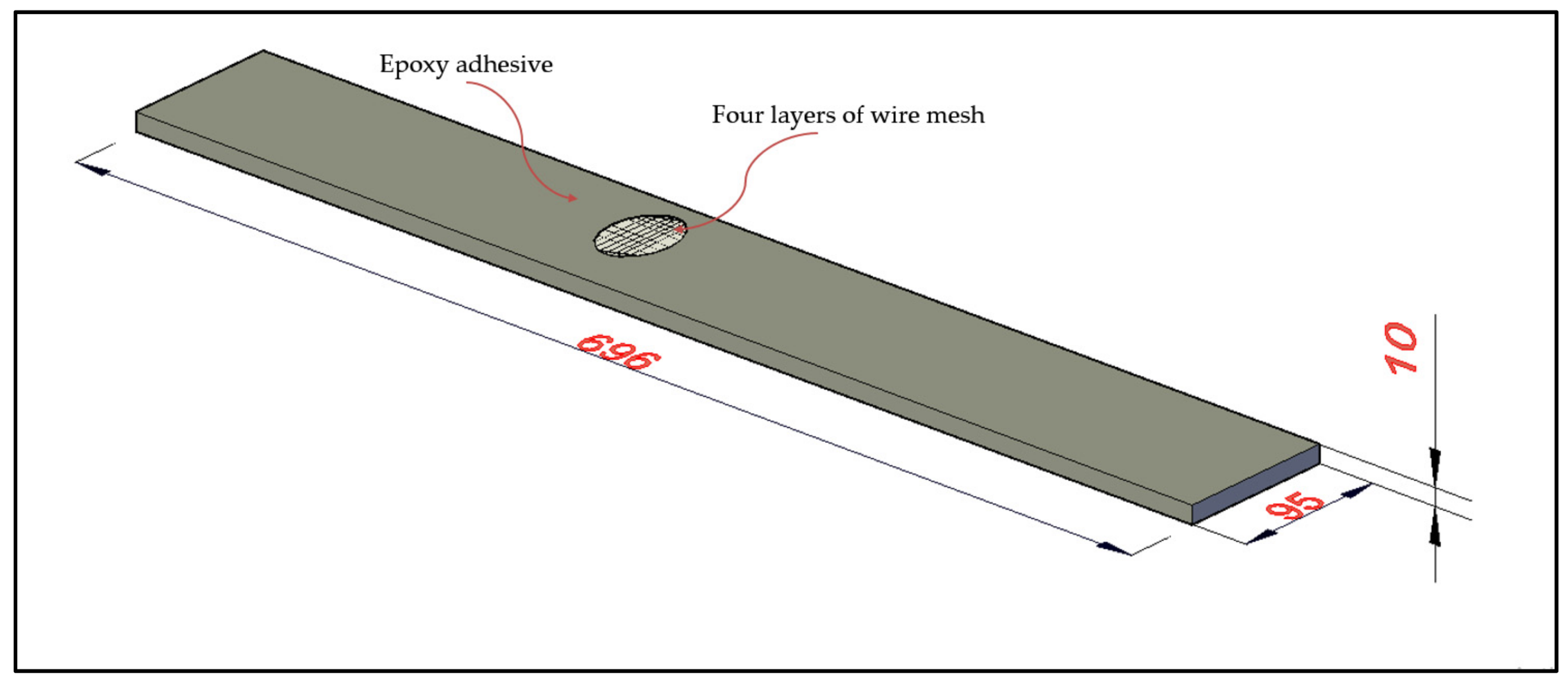
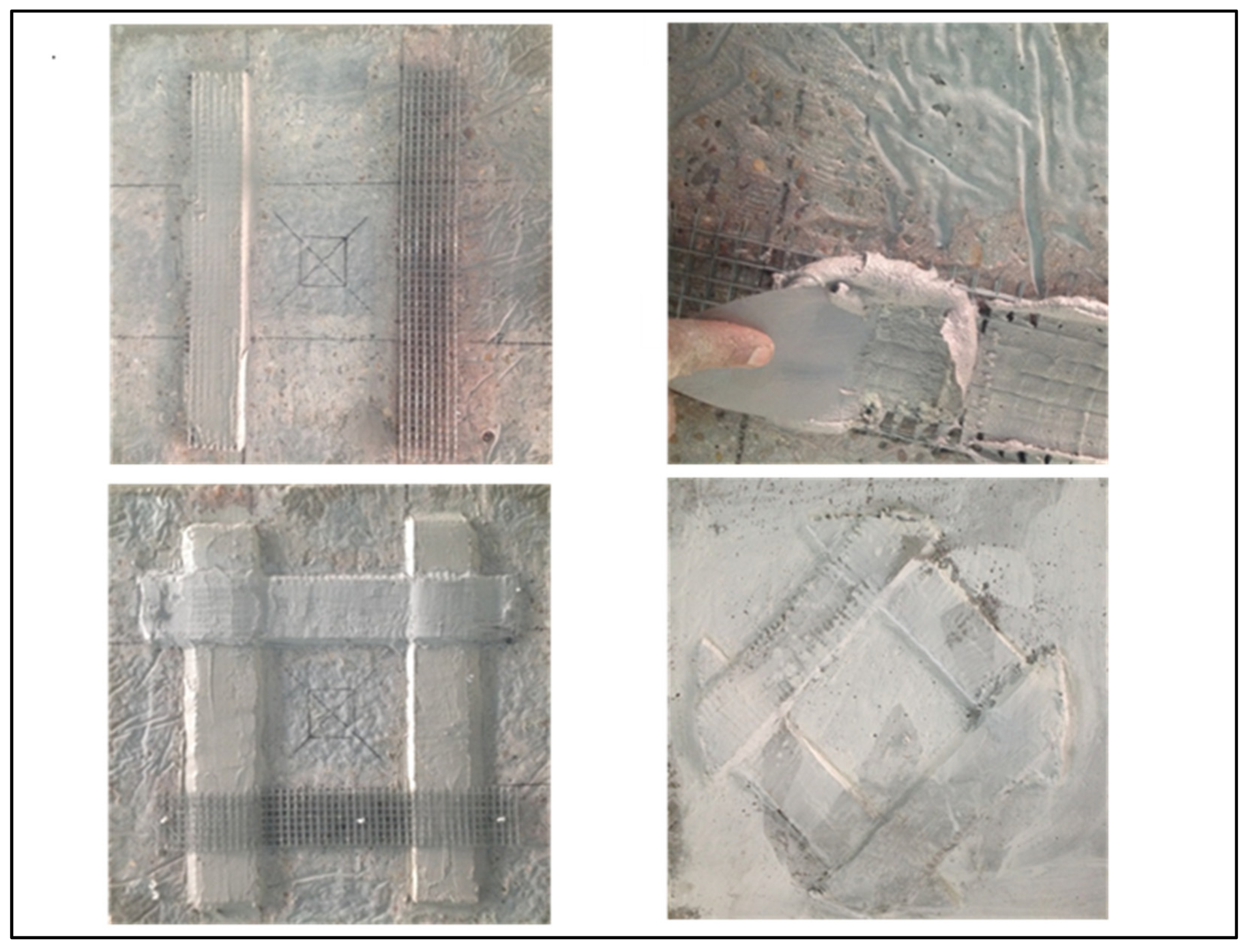
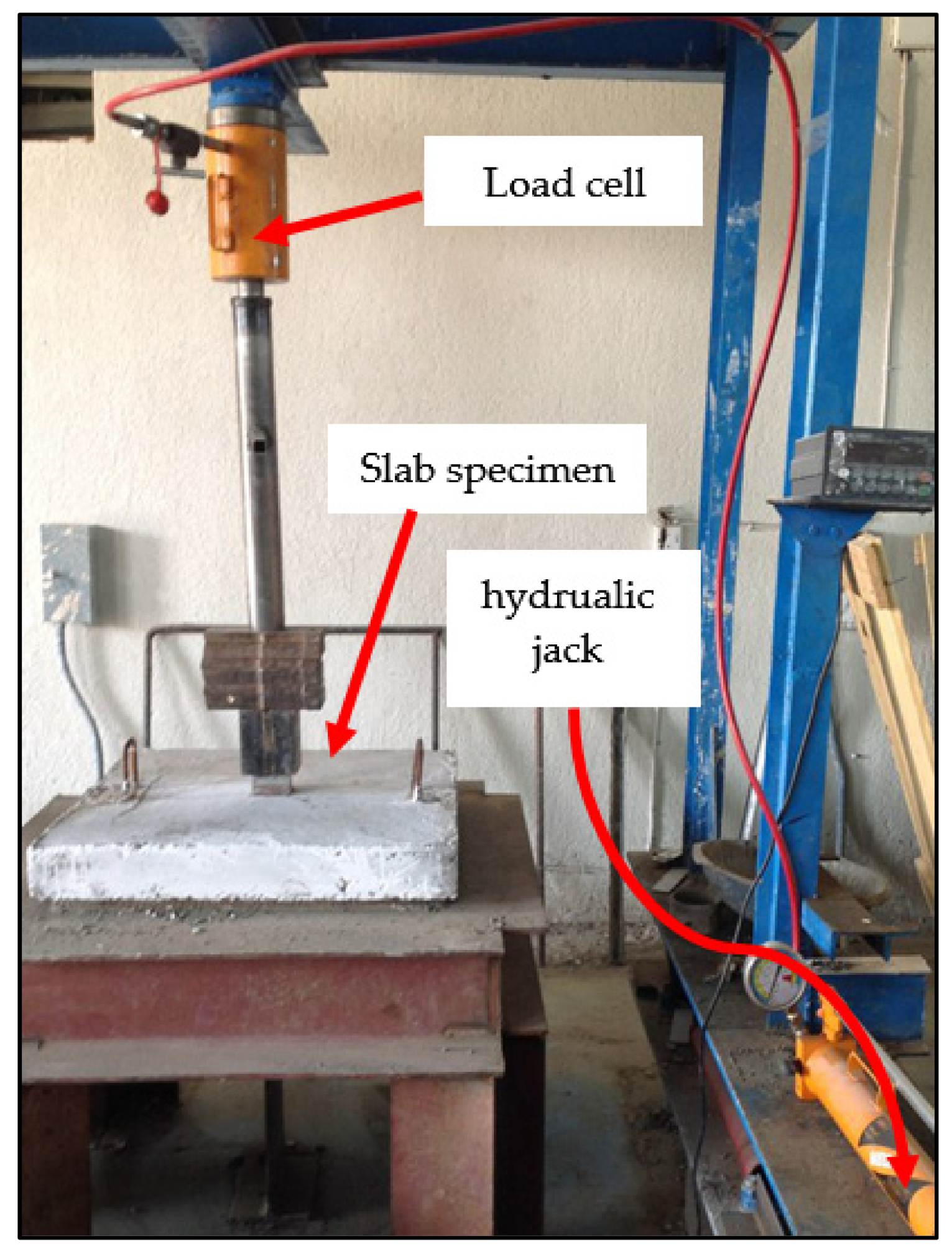
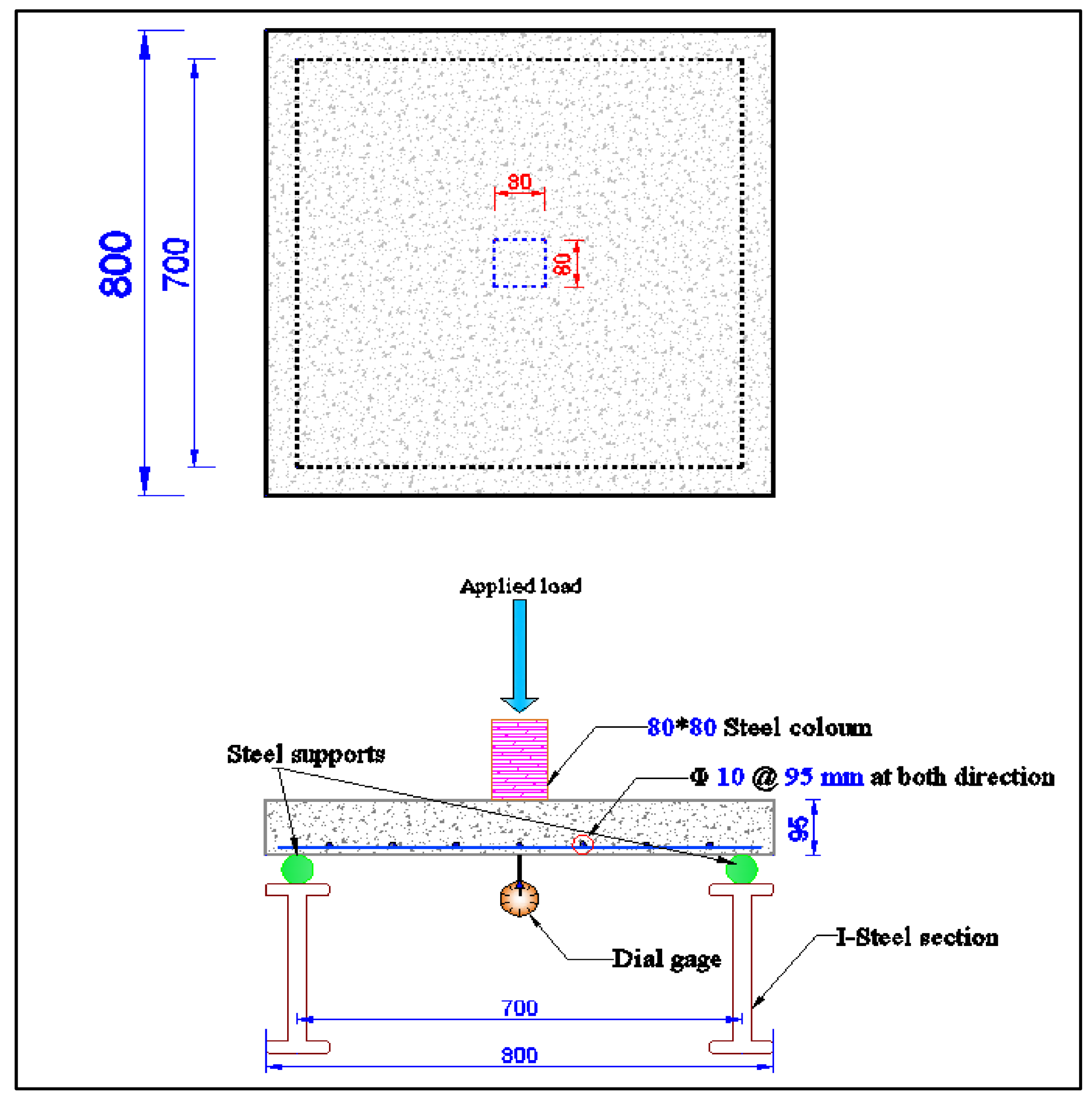
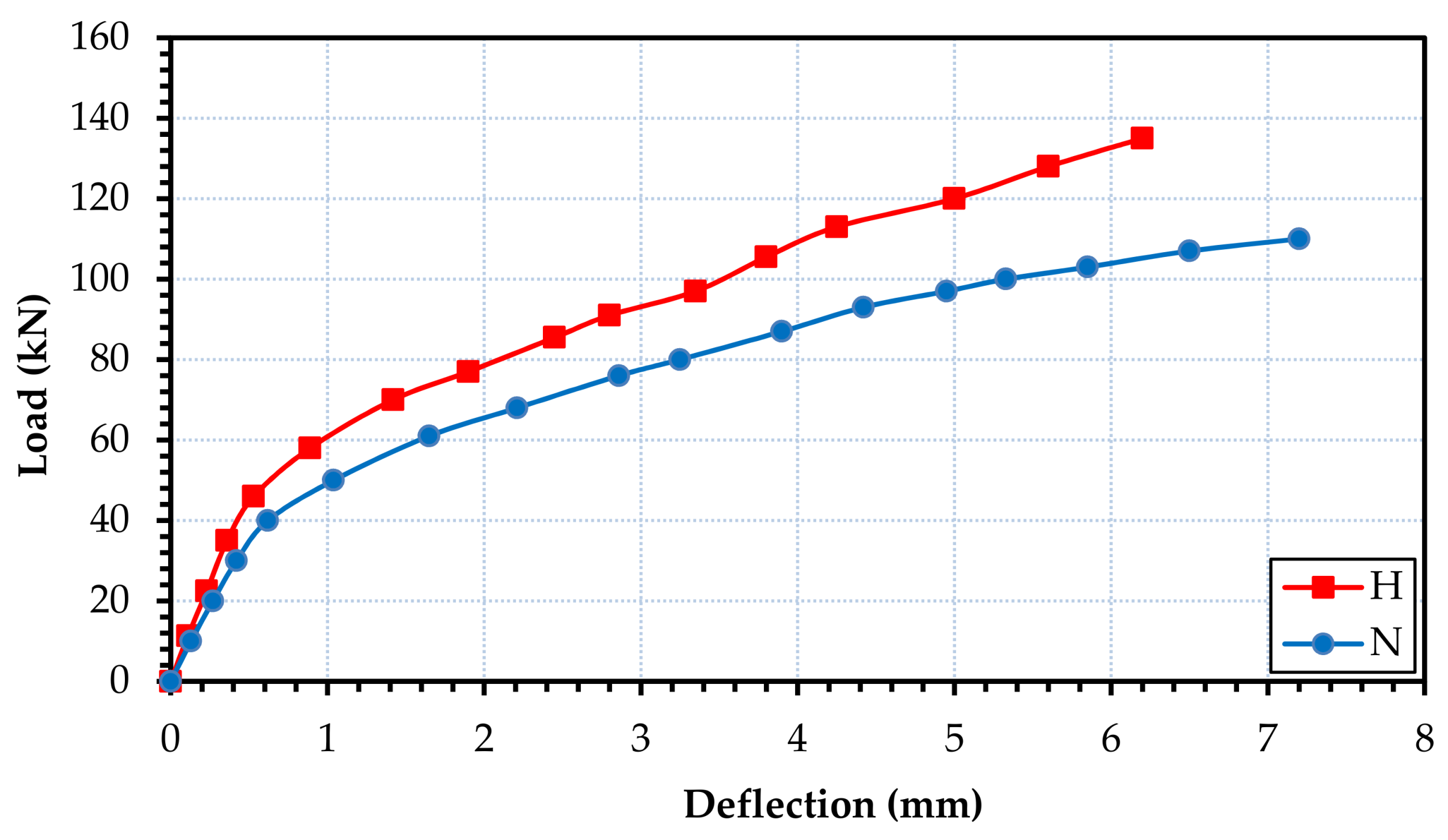
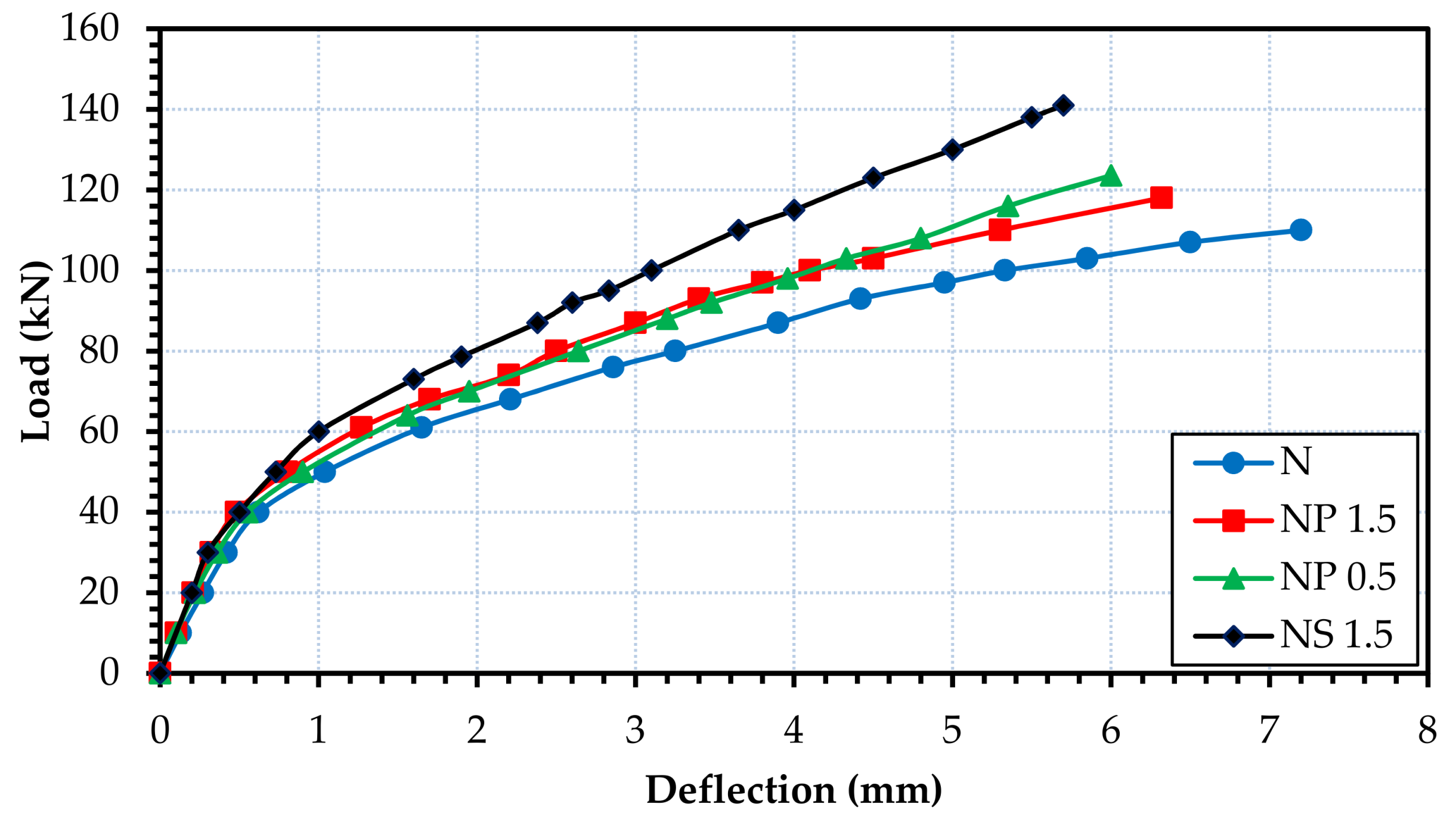
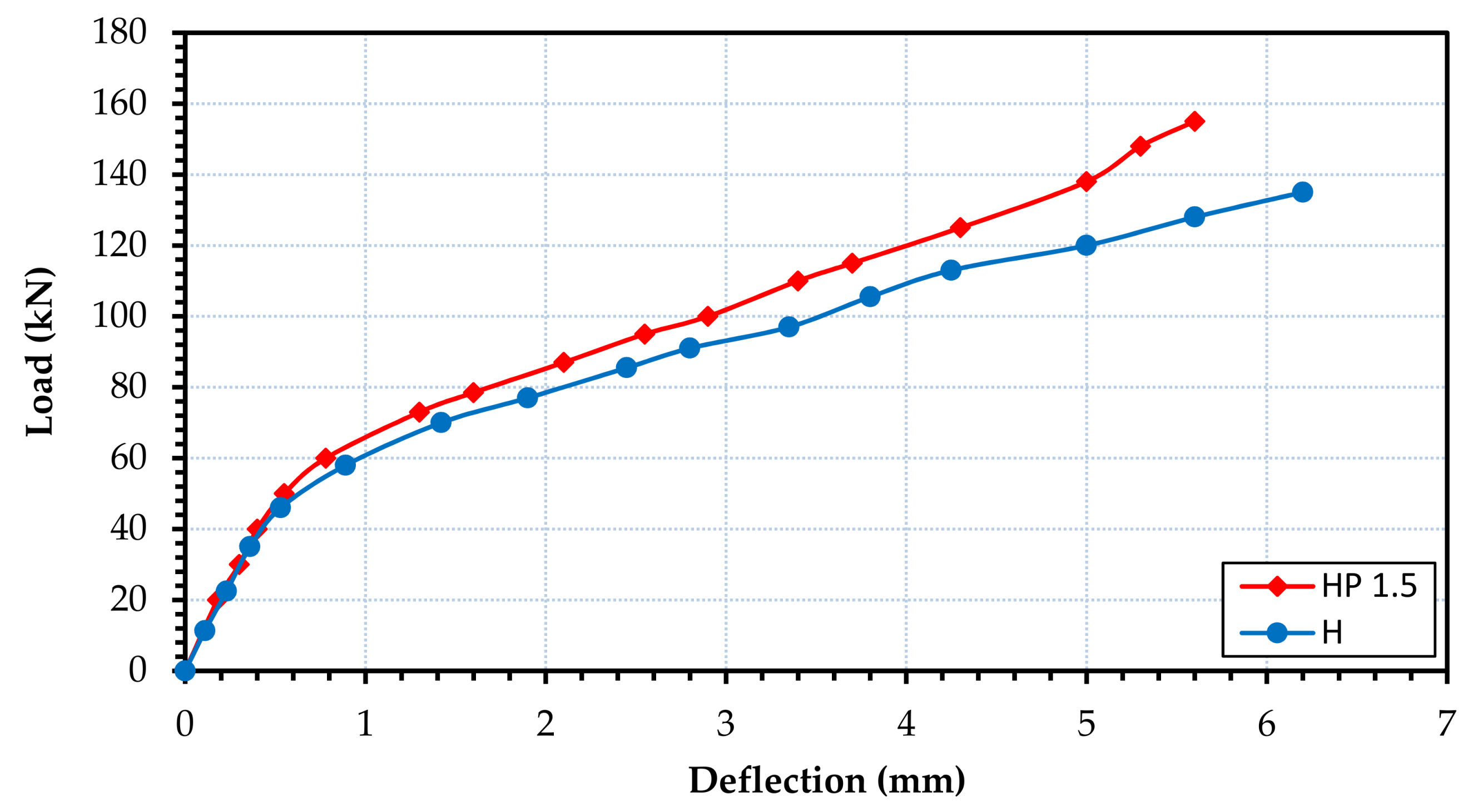
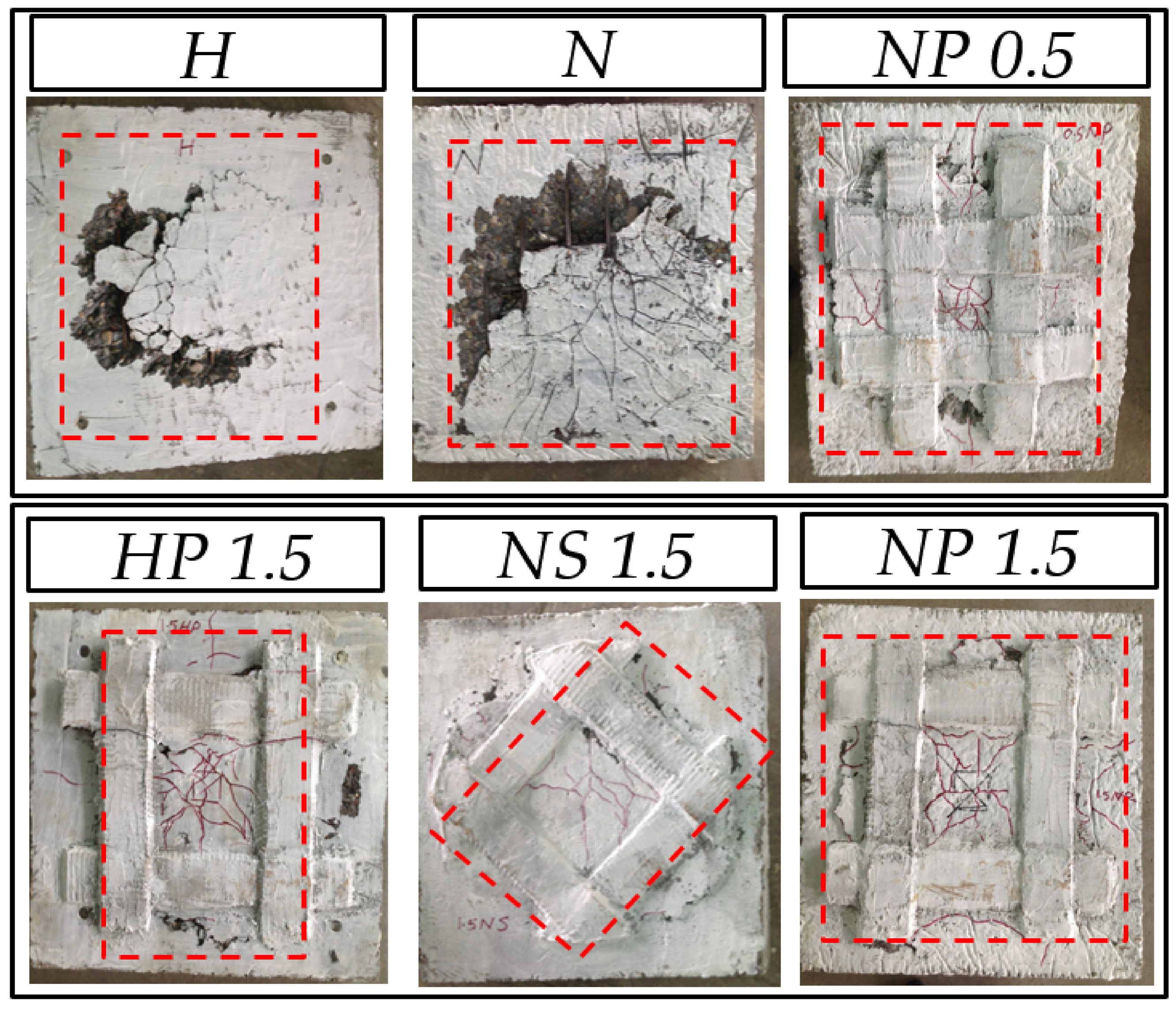

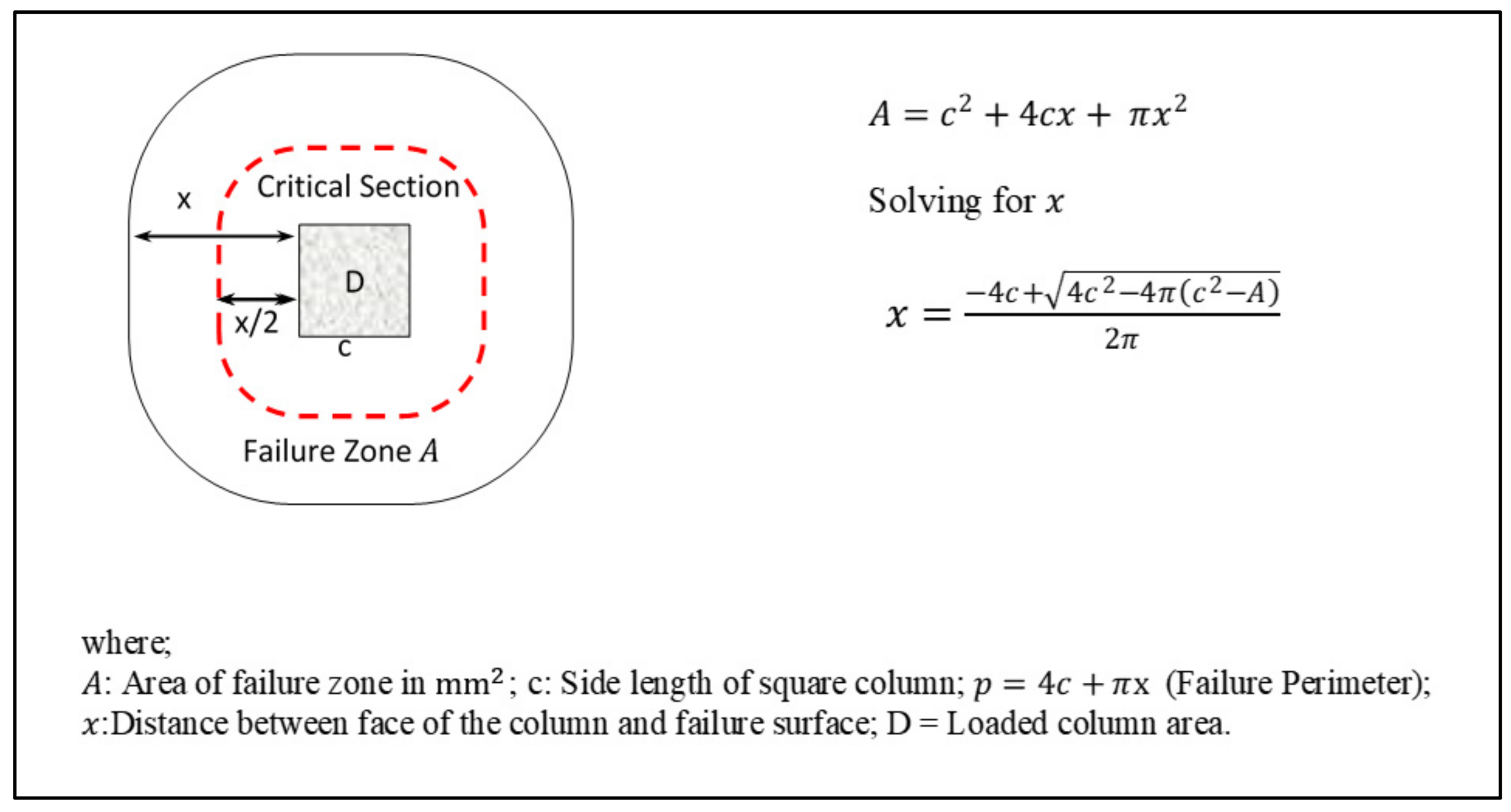
| Slab No. | Concrete Compressive Strength (MPa) | Strengthening Configuration |
|---|---|---|
| N | 30 | --- |
| NP 0.5 | 30 | Parallel to the column face and at 0.5 d from column’s face |
| NP 1.5 | 30 | Parallel to the column face and at 1.5 d from column’s face |
| NS 1.5 | 30 | Parallel to diagonals and at 1.5 d from column’s corner |
| H | 65 | --- |
| HP 1.5 | 65 | Parallel to the column face and at 1.5 d from column’s face |
| Concrete Type | Cement Content (kg/m3) | Coarse Aggregate (kg/m3) | Fine Aggregate (kg/m3) | Water/Cement | Superplasticizer (L/m3) |
|---|---|---|---|---|---|
| N | 325 | 1150 | 650 | 0.5 | - |
| H | 530 | 950 | 680 | 0.3 | 12 |
| Concrete Type | Compressive Strength * (MPa) | Tensile Strength (MPa) |
|---|---|---|
| N | 30 | 3.3 |
| H | 65 | 7.0 |
| Bar Size (mm) | Test Results | ASTM A615M | ||||
|---|---|---|---|---|---|---|
| Yield Stress (MPa) | Ultimate Strength (MPa) | Elongation% | Yield Stress (MPa) | Ultimate Strength (MPa) | Elongation % | |
| 10 | 510 | 657 | 13.9 | 420 | 620 | 9 |
| Test Slab | Effective Depth d (mm) | Measured Experimental Results | The Distance of Critical Punching Section from Column Face | ||||
|---|---|---|---|---|---|---|---|
| Punching Failure Area (mm2) | Critical Failure Distance (x/2) (1) | FailureAngleϕ (2) | ACI 318 d/2 | BS 8110 1.5 d | CEB -1990 2 d | ||
| N | 65 | 160,033 | 88 | 20.3 | 32.5 | 97.5 | 130 |
| NP 0.5 | 65 | 128,026 | 74 | 23.7 | |||
| NP 1.5 | 65 | 121,625 | 71 | 24.6 | |||
| NS 1.5 | 65 | 108,822 | 66 | 26.2 | |||
| H | 65 | 194,490 | 100 | 18.1 | |||
| HP 1.5 | 65 | 161,425 | 86 | 20.7 | |||
| Test Slab | Concrete Comp. Strength (MPa) | Effective Depth (mm) | Ultimate Load (kN) | Perimeter of Punched Area (*) (mm) | Ultimate Punching Shear Strength (MPa) | ACI 318 (V) (1) (kN) (V)MPa | BS 8110 (V) (2) (kN) (V)MPa | CEB-90 (V) (3) (kN) (V)MPa |
|---|---|---|---|---|---|---|---|---|
| N | 30 | 65 | 110 | 873 | 1.94 | (60.2) 1.60 | (99) 1.4 | (85.5) 1.16 |
| NP 0.5 | 30 | 65 | 124 | 785 | 2.42 | |||
| NP 1.5 | 30 | 65 | 118 | 766 | 2.37 | |||
| NS 1.5 | 30 | 65 | 141 | 735 | 2.95 | |||
| H | 65 | 65 | 135 | 945 | 2.20 | (88.6) 2.35 | (128) 1.8 | (110.6) 1.50 |
| HP 1.5 | 65 | 65 | 155 | 860 | 2.77 |
| Test Slab | ||||
|---|---|---|---|---|
| N | 7.2 | 110 | 11.6 | 175 |
| NP 0.5 | 6.0 | 124 | 10.9 | 209 |
| NP 1.5 | 6.3 | 118 | 11.1 | 195 |
| NS 1.5 | 5.7 | 141 | 11.4 | 252 |
| H | 6.2 | 135 | 11.7 | 193 |
| HP 1.5 | 5.6 | 155 | 10.2 | 210 |
© 2019 by the authors. Licensee MDPI, Basel, Switzerland. This article is an open access article distributed under the terms and conditions of the Creative Commons Attribution (CC BY) license (http://creativecommons.org/licenses/by/4.0/).
Share and Cite
Jaafer, A.A.; AL-Shadidi, R.; Kareem, S.L. Enhancing the Punching Load Capacity of Reinforced Concrete Slabs Using an External Epoxy-Steel Wire Mesh Composite. Fibers 2019, 7, 68. https://doi.org/10.3390/fib7080068
Jaafer AA, AL-Shadidi R, Kareem SL. Enhancing the Punching Load Capacity of Reinforced Concrete Slabs Using an External Epoxy-Steel Wire Mesh Composite. Fibers. 2019; 7(8):68. https://doi.org/10.3390/fib7080068
Chicago/Turabian StyleJaafer, Abdulkhaliq A., Raid AL-Shadidi, and Saba L. Kareem. 2019. "Enhancing the Punching Load Capacity of Reinforced Concrete Slabs Using an External Epoxy-Steel Wire Mesh Composite" Fibers 7, no. 8: 68. https://doi.org/10.3390/fib7080068
APA StyleJaafer, A. A., AL-Shadidi, R., & Kareem, S. L. (2019). Enhancing the Punching Load Capacity of Reinforced Concrete Slabs Using an External Epoxy-Steel Wire Mesh Composite. Fibers, 7(8), 68. https://doi.org/10.3390/fib7080068





